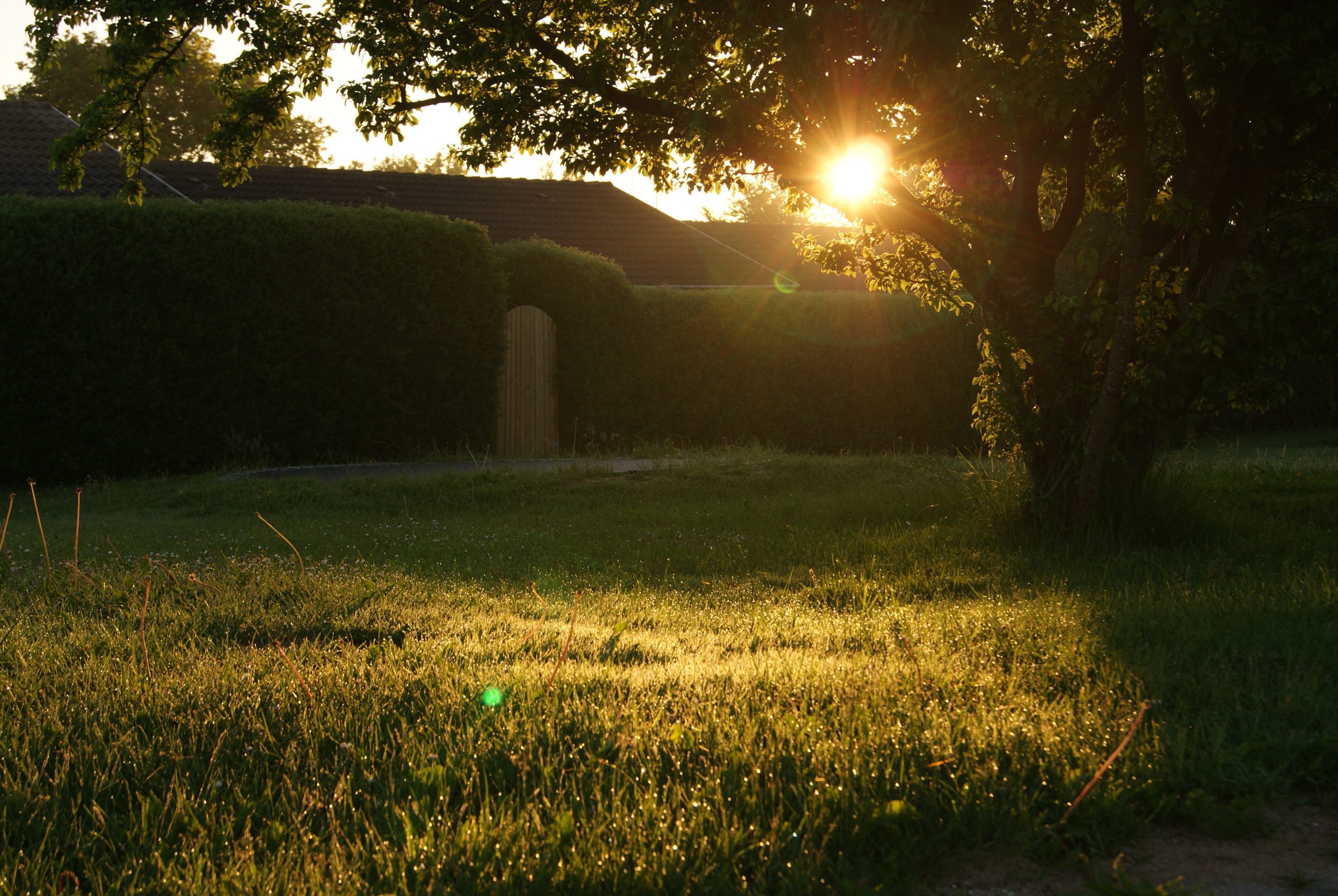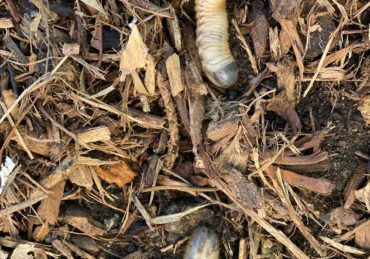A lawn care schedule tailored to your grass type, for warm-season grasses is essential for maintaining a healthy lawn year-round by addressing specific lawn needs each season. In spring, prepare the yard by removing debris, test soil, and apply pre-emergent herbicides. Mow to a height of 2-2.5 inches. During summer, maintain a mowing height of 1-1.5 inches, guarantee consistent watering, and fertilize with nitrogen. In fall, retest soil, aerate, and overseed if needed. Winter requires monitoring debris and preparing irrigation systems for dormancy. Each season carries specific tasks to enhance lawn health. Uncovering more detailed strategies can guarantee peak performance for your warm-season grass.
Spring Lawn Care Calendar for Warm-Season Grasses (March, April, May)
As spring approaches, it is vital to clean and prepare the yard to guarantee ideal growth for warm-season grasses. Spring is when grass starts to emerge from dormancy, making it the ideal time to clean, fertilize, and prepare the lawn for vigorous growth.
Essential lawn maintenance tasks during this period include the first mowing, soil amendments based on testing, and consistent watering to support healthy development.
Clean and Prepare the Yard
Spring lawn care for warm-season grasses begins with a thorough cleaning and preparation of the yard, starting in March by removing debris such as leaves and sticks to encourage healthy grass growth as the turf emerges from dormancy.
This essential first step not only clears the way for sunlight and airflow but also helps prevent pests and diseases.
Concurrently, conducting soil tests is important to assess nutrient levels and pH, providing valuable information for effective fertilizer and soil amendments later in the season.
By taking these proactive measures to clean and prepare the yard, homeowners lay the groundwork for a lush, vibrant lawn that thrives throughout the active growing months ahead.
Proper preparation is critical for optimum results.
Essential Lawn Maintenance Tasks
With the yard prepared and cleaned, homeowners can now focus on implementing key lawn maintenance tasks to guarantee the health and vibrancy of warm-season grasses during the critical months of March, April, and May.
Begin by mowing when grass reaches 2-2.5 inches, adhering to the one-third rule to avoid stress. Regularly mow your lawn to maintain this height, encouraging even growth and a healthier turf as the season progresses.
Before the first mow, inspect and tune up your lawn mower to ensure it’s ready for consistent use throughout the growing season.
In mid-February, apply pre-emergent herbicides to thwart weed growth as soil temperatures rise to around 55°F by mid-April.
March is also the time for dethatching and debris removal to enhance growth.
In April, overseed any thin patches and maintain adequate watering to support germination.
Summer Lawn Care Schedule for Warm-Season Lawn Grass (June, July, August)
During the summer months, maintaining warm-season grasses requires diligent attention to mowing and watering practices.
Proper mowing height and timely irrigation are vital for promoting healthy growth and minimizing moisture loss.
Furthermore, effective fertilization and vigilant pest control are essential to prevent damage and guarantee a thriving lawn throughout June, July, and August.
Mowing and Watering Guidelines
Maintaining an ideal mowing height of 1 to 1.5 inches is essential for warm-season grasses throughout the summer months to provide shade to the soil and minimize moisture evaporation.
Proper mowing practices are important; avoid excessive cutting to prevent stress on the grass. When you mow, make certain that grass blades are left long enough to encourage deep rooting and resilience.
For established lawns, it is recommended to water your lawn with 1 to 1.25 inches of moisture per week, preferably in the early morning to reduce evaporation and fungal risks.
Adjust your watering frequency based on rainfall and heat conditions, as consistent moisture is critical for recovery from drought stress, maintaining a healthy and vibrant lawn throughout the summer.
Fertilization and Pest Control
Effective fertilization and pest control practices are essential for ensuring the health and vigor of warm-season grasses throughout the summer months.
Fertilization should ideally occur in late spring to early summer, focusing on nitrogen to support active growth while avoiding applications during peak heat to prevent stress and potential burning.
Concurrently, pest control is crucial, as common lawn pests like grubs and sod webworms are most active during this period; timely monitoring and treatment can mitigate damage.
Furthermore, applying fungicides may be necessary to manage lawn diseases that flourish in warm, humid conditions, often presenting as circular brown patches.
Together, these practices promote resilient, lush lawns capable of withstanding summer challenges.
Fall Lawn Care for Warm-Season Grasses (September, October, November)
As fall approaches, proper care for warm-season grasses is essential to guarantee their health and resilience through the winter months.
Key practices during this period include soil health and nutrient management, aeration, overseeding, and disease control.
Soil Health and Nutrient Management
To guarantee ideal soil health and nutrient management for warm-season grasses during the fall months, it is essential to implement targeted practices that address soil conditions and prepare the lawn for dormancy.
Conducting soil testing in early September is vital to identify any nutrient deficiencies and determine the necessary soil amendments. Based on the results, adjustments to the pH level may be required, such as applying lime to combat acidity.
In October, make final soil corrections and ensure that your lawn receives adequate nutrients before winter. This proactive approach not only enhances soil health but also promotes a robust foundation for the grass to thrive in the subsequent growing season.
Such practices ensure the lawn remains resilient and healthy through dormancy.
Aeration, Overseeding, and Disease Control
Implementing aeration and overseeding strategies during the fall months is important for maintaining the health and resilience of warm-season grasses as they prepare for dormancy.
In September, reduce watering and apply pre-emergent herbicides to prevent winter annual weeds. Overseeding in the fall can fill in thin or bare areas, encouraging new grass to establish before winter dormancy.
October is ideal for aeration, which alleviates soil compaction and enhances root access to nutrients and water, essential after summer stress. Overseeding with cool season grass seed such as cool-season perennial ryegrass—can provide color and improve winter appearance.
In November, it is critical to fertilize overseeded lawns, treat existing weeds, and mulch fallen leaves to prevent smothering the grass.
This thorough approach to fall lawn care guarantees effective disease control and prepares the lawn for a robust return in the spring.
Winter Lawn Care for Warm-Season Grasses (December, January, February)
During the winter months, warm-season grasses enter a period of dormancy, necessitating specific care strategies to protect and maintain the lawn.
It is vital to manage weeds and guarantee that any water needs are addressed, as this can prevent damage and prepare the grass for the upcoming growing season.
Furthermore, regular monitoring of lawn conditions can help identify potential issues that may arise under winter stress.
Protect and Maintain Dormant Lawns
Winter months necessitate minimal maintenance for dormant warm-season grasses, focusing primarily on debris removal and soil health preparation for ideal growth in spring.
Regularly clearing leaves and branches from dormant lawns is essential to prevent disease and keep your lawn in optimal condition for regrowth come spring.
To enhance soil quality, conduct a soil test in late winter to assess nutrient levels and pH, facilitating timely amendments before the growing season begins.
Furthermore, monitor your irrigation system to verify it is properly winterized, allowing for efficient operation when temperatures rise.
Avoid heavy foot traffic on dormant lawns to minimize soil compaction and protect the grass crowns, mitigating potential damage that could hinder recovery as spring approaches.
Weed and Water Management
Effective weed and water management is fundamental for maintaining the health of dormant warm-season grasses throughout the winter months.
To guarantee effective weed control, apply pre-emergent herbicides before soil temperatures rise above 50°F, as winter weeds can thrive and compete for resources. Regular inspections for these weeds are essential, as they can disrupt the dormancy of warm-season grasses.
During winter, watering is generally unnecessary; however, monitor for drought conditions and verify the lawn receives adequate rainfall if needed.
In addition, removing debris such as leaves and twigs is important to prevent mold and promote sunlight penetration for the grass as it begins to awaken in spring.
Soil testing in late winter can further inform nutrient management strategies.
Frequently Asked Questions
How to Care for Warm Season Grasses?
Caring for warm-season grasses involves regular mowing, adequate watering of 1 to 1.5 inches weekly, timely fertilization during the growing season, and vigilant pest monitoring, alongside seasonal practices like aeration to enhance lawn health.
What Maintenance Practice Is Recommended for a Warm Season Lawn?
Recommended maintenance practices for a warm season lawn include regular mowing, appropriate watering (1 to 1.5 inches weekly), timely fertilization during peak growth, and vigilant pest and disease monitoring to guarantee peak turf health.
When Should I Fertilize My Warm Season Grass?
Fertilization of warm season grasses is ideally recommended between late spring and early summer, specifically from April to June, ensuring ideal nutrient absorption and promoting vigorous growth during the grass’s active growing season.
In What Order Should I Treat My Lawn?
To effectively treat your lawn, begin with pre-emergent herbicides in early spring, followed by fertilization in late spring, consistent mowing throughout summer, pest monitoring, and concluding with overseeding and herbicide application in fall for weed prevention.





